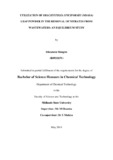Please use this identifier to cite or link to this item:
https://cris.library.msu.ac.zw//handle/11408/719| Title: | Utilization of brachystegia spiciforms (msasa) leaf powder in the removal of nitrates from wastewaters: an equilibrium study | Authors: | Hungwe, Isheanesu | Keywords: | Brachystegia spiciformis | Issue Date: | 2014 | Publisher: | Midlands State University | Abstract: | The investigation of nitrate adsorption onto Brachystegia spiciformis leaf powder from waste waters was performed. Characterization for the functional groups of the biomass before and after nitrate sorption as well as after desorption was done using an FTIR spectrophotometer. The effect of pH, contact time, dosage and initial nitrate concentration was investigated. The Brachystegia spiciformis leaf powder had amine, carboxylic and hydroxyl groups that were involved in nitrate removal from aqueous environment. Optimum conditions for nitrate uptake were at pH 4, contact time of 30 minutes and biosorbent dose of 1.5 g and varying nitrate initial concentrations from 5 to 50 mg L-1. The equilibrium data generated from the nitrate initial concentrations fitted the isotherms in the order Dubinnin-Radushkevich ˂ Halsey ꞊ Freundlich ˂ Langmuir ˂ Temkin with correlation coefficient, R2, values 0.9683, 0.9686, 0.9686, 0.9692 and 0.9792 respectively. The Freundlich`s adsorption intensity, n, (0.1 ˂ 1𝑛⁄ ˂ 1) and the Langmuir`s separation factor, 𝑅𝐿, (0 < 𝑅𝐿 < 1) revealed nitrate sorption favourability onto Brachystegia spiciformis leaf powder with the Langmuir`s sorption capacity of 1.6297 mgg-1. Halsey and Freundlich isotherms evidenced surface heterogeneity and that the Brachystegia spiciformis had macro and micro pores. The Temkin and Dubinnin-Radushkevich isotherms indicated that the sorption process was based on physisorption and it was evidenced by heat of sorption constant, 𝑏𝑣. Nitrate desorption from the loaded Brachystegia spiciformis was achieved by increasing pH to alkaline conditions and the highest desorption ratio was achieved at 91.26 % at pH 11. After desorption the FTIR spectrum of Brachystegia spiciformis did not retain back its original spectrum. | URI: | http://hdl.handle.net/11408/719 |
| Appears in Collections: | Bsc Chemical Technology Honours Degree |
Files in This Item:
| File | Description | Size | Format | |
|---|---|---|---|---|
| project-Isheanesu.pdf | 1.16 MB | Adobe PDF |  View/Open |
Page view(s)
120
checked on Feb 26, 2025
Download(s)
54
checked on Feb 26, 2025
Google ScholarTM
Check
Items in MSUIR are protected by copyright, with all rights reserved, unless otherwise indicated.


